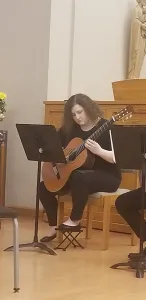
Adaptions have to be made with COVID 19. Alongside Back Mountain Music Therapy, I also am the Music Therapy Clinic Supervisor at Maywood University. When Music Therapy students finish their course- work for their bachelor degree, they then have to do an internship supervised by a certified Music Therapist. Some students intern with private Music Therapy companies, others go to larger companies where Music Therapists are employed as health team members. Back Mountain Music Therapy has been training interns since 2016. COVID 19 has made all of us have to think outside the box.
I was approached by our program director when one of our former students had to abruptly leave her much loved, internship site, due to covid. Carly had been working in hospice, and abruptly, COVID 19 ended her internship. She has joined Back Mountain Music Therapy to finish her internship hours.
For many people, change is a part of life- you grow, you learn, you develop. It is just something you get used to. Recently, there is an abundance of change for everyone, as COVID-19 has left many with orders to stay home and only travel when absolutely necessary. For those of us who are used to a typical work schedule, being extroverted, and being able to see friends on a regular basis, this change may not be easy for us.
Change has not always been easy for me because it means getting used to something new and a shift in routine. I am currently a music therapy intern at Back Mountain Music Therapy (BMMT) by online means. I had a music therapy internship through Big Bend Hospice which was unfortunately cut short due to the coronavirus, which meant dealing with the ever-changing environment caused by COVID-19. Going from an in-person music therapy internship to an online one has difficult, but there is one thing that is universal – the core principles.
The core principles of music therapy are virtually the same, no matter what population you work with in music therapy. The main points of music therapy are a concentration of the therapist/client relationship, following a client’s lead, and looking at the individual as a whole person. Whether you are working with Hospice patients, individuals with intellectual and developmental disabilities, patients with traumatic brain injuries, clients with mental health needs, or patients that fall in another population, these three core concepts are universally similar amongst music therapists.
During my time at Big Bend Hospice and BMMT, it has become apparent that building rapport with clients provides a strong foundation of trust and understanding between music therapist and client. This foundation provides an unspoken ease which helps to allow clients to feel comfortable in a musical environment. Additionally, as music therapists, we typically view the client as a whole person, as more than just their diagnosis or disability, regardless of population.
Through a client-centered approach, music therapists follow the client’s lead in sessions, which may look different depending on the population you are providing services. In a hospice setting, following a client’s lead may look like providing the client with a list of patient-preferred songs to choose from, or providing a simple framework for life review. At BMMT (a private practice setting), you may find that following the client’s lead may look like the therapist matching musical improvisation to client’s movements, vocalizations, and overall affect to draw the client into musical play. In almost all music therapy settings, music therapists are looking for how the client is reacting to the music. A client’s reaction can involve body movement (i.e. rocking back and forth, moving to the beat of the music, tapping fingers, moving extremities), facial affect and body language (i.e. smiling, furrowed brow, grimacing, crying, arms crossed, looking away/towards music therapist, closing eyes etc.), and prosody (tonality of voice). The reactions received from patients during sessions are understood by music therapists and therapists adapt musical stimuli to engage and communicate with clients effectively. For example, in a Hospice setting, this may look like music therapist is providing patient preferred music to a client, when they appear to become drowsy. A music therapist would analyze this behavior and may seek to rouse a patient by increasing the volume and tempo of musical stimuli gradually over a few minutes to promote the client’s engagement in the session. In a BMMT session, the therapist may notice a client wandering around the room, analyzing every inch of space and “taking it all in;” the therapist would in turn match the client’s behavior using an instrument that would parallel the client’s meandering behavior.
These core principles of music therapy are universal, and because these core principles are relatively unchanging, it makes the situation we are living in today a little more manageable. Transferring from an in-person internship to an online one, although semi-daunting, seems practicable
because all music therapists work towards the same over-arching goal of improving our patients’ quality of life using these three universal music therapy core principles. If one acknowledges the core concepts of practicing music therapy, working with various populations becomes a similar practice.
Carly Flohs

Listening to Carly speak about her hospice work, it is visibly evident, that she will one day make a big difference to many, as a Hospice Music Therapist. Carly’s persistent dedication to her studies is matched by her sincere motivation for her work in hospice Music Therapy. Back Mountain Music Therapy has been fortunate to have someone that is so dedicated to helping others towards life’s end, to join our internship.


Leave a Reply